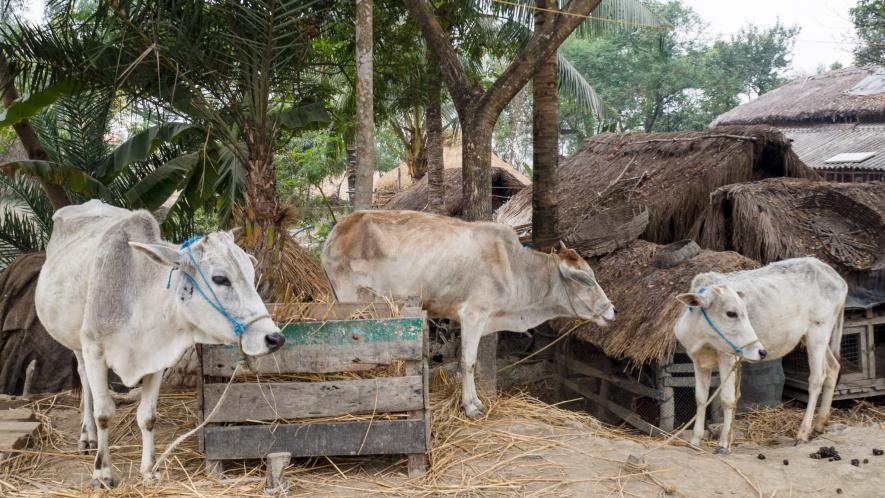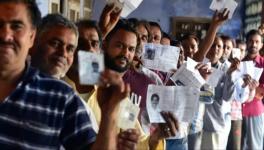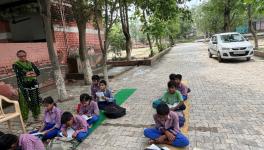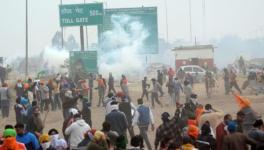COVID-19 In Rural India-XXXIII: Villagers from Gijhi Fear Starvation of People, Cattle

Representational image. | Image Courtesy: Wikipedia
This is the 33rd report in a series that provides glimpses into the impact of COVID-19-related policies on life in rural India. The series, commissioned by the Society for Social and Economic Research, comprises reports by various scholars who have been conducting village studies in different parts of India. The reports have been prepared on the basis of telephonic interviews with key informants in their study villages. This report talks about the difficulties Gijhi village of Haryana’s Rohtak district is witnessing amid the lockdown.
Gijhi village is located in Rohtak district of Haryana. It is approximately 30 km away from Rohtak, the district headquarters and about four km away from the sub-divisional office at Sampla. The total geographical area of the village is 661 hectares.
When I surveyed the village in 2017-18 as part of my doctoral research, the village had 704 households across 11 caste groups. At 353 households, Jats formed the biggest caste group in the village. Other Backward Classes (OBC) represented in the village were Bairagi, Khati, Kumhar, Lohar, Chhippi, Maniyar and Jheemar. Chamar, Dhanak and Valmiki were the major Scheduled Caste groups in the village.
Most of the agricultural land is owned by the Jat households. Bairagi households (9% of all households) own 3% of the total agricultural land of the village, and Khati households (3% of all households) own 1% of the total agricultural land. One percent of the total agricultural land is owned by OBC households. Wheat, fenugreek (methi), onion, berseem (green fodder) and mustard are the major rabi crops grown here, while paddy, millet (bajra), pigeon pea (arhar dal) and Sesbania bispinosa (jantar) are the major crops grown in the kharif season. The cultivation of paddy, currently the most important kharif crop in the village, began in the village only about two decades ago.
Jat and OBC households are situated in mixed neighbourhoods, but Dalit households are situated in one corner of the village. All the Dalit households are landless and casual wage labour is the primary source of livelihood for most of them. Members of these households work as construction labourers, agricultural labourers, barbers as well as in meat shops and grocery shops. Some rear cattle and pigs, and some work as hawkers selling vegetables and footwear. The hawkers travel to other villages and towns to sell goods on piece-rated contracts for contractors. Women mostly work within the village as agricultural workers on piece-rated contracts.
For this report, I conducted telephonic interviews with 10 people between April 4 and 25 to assess the impact of the lockdown on the village. My respondents include one chowkidar (a government-appointed village watchman who maintains civil registration and other records), one agricultural labourer, one construction worker, three shopkeepers, one farmer, one anganwadi worker, one daily wage labourer and the head of the village.
Agriculture in Gijhi has been severely affected by the lockdown. This year, the rabi harvest was delayed by about 15 days. By April 25, when I conducted the last round of my telephonic interviews, most of the wheat had been harvested. My respondents estimated that about two-thirds of the wheat was harvested using combine harvesters while the rest was gathered by hand. They reported that hiring workers for the wheat harvest had been challenging, as agricultural labourers were reluctant to go to the fields for the fear of police persecution.
The respondents also reported finding it difficult to sell their rabi harvests. Procurement of wheat and mustard at the local mandi began on April 20. In normal years, farmers would take wheat to the market directly from the field after harvesting was completed. This year, they have to wait for the mandi to issue them a token that will allow them to do so. A very small number of tokens are issued for each day and the majority of the farmers in this village are still awaiting their turn. According to one respondent, even those farmers who harvested early and were among the first to register to be able to sell have not yet been able to sell their entire harvests. This is because, until recently, each token only allowed a farmer to sell 50 quintals of wheat or 40 quintals of mustard. This restriction has been removed recently after the farmers protested. According to my respondents, not more than a quarter of the wheat produced in the village had been sold by the third week of April. Very few farmers grow mustard in Gijhi, but most of those who had done so had sold their harvests by the third week of April.
My respondents pointed out that it is risky for farmers to store their harvested crops for a long time. Currently, the harvested wheat is being stored in fields, in homes, in courtyards and in cattle sheds. These makeshift storage areas are not entirely secure, and the grain is at risk of being ruined when it rains.
When I did my last round of interviews (April 25), the administration had closed down the mandi for three days because an individual in a nearby village had tested positive for COVID-19. This has resulted in panic all around and the farmers are worried that if further positive cases are discovered, the mandi will be shut down.
Farmers in Gijhi grow maize and bajra for green fodder after the harvesting of the wheat crop and before the sowing of the kharif paddy. The delay in the harvesting and sale of the wheat crop has led to a delay in the sowing of these interim crops. If farmers are unable to grow these crops before it is time for them to start preparing the land for paddy, they are likely to face a shortage of fodder for their livestock in the coming months.
Livestock economy
The lockdown has also adversely affected the livestock economy. The delay in the harvesting of wheat caused a shortage of dry fodder in the initial days of the lockdown. Most households that rear cattle do so in order to sell milk. Some of the villagers commute to Delhi by train to sell milk there, so the suspension of train services during the lockdown has hit the dairy business in the village hard. Many livestock farmers are finding it difficult to buy fodder and feed for their cattle because of the sudden fall in their incomes.
Also read: COVID-19 in Rural India-XXX: Impact of Lockdown on Tea Plantation of Thettamala, Kerala
Impact on agricultural labourers and other workers
One landless respondent said that his entire household is dependent on agricultural labour wage for their income. In the current season, they typically harvest carrots, plant onions, clean cauliflower and harvest wheat and mustard. Work to do with vegetable crops is done mostly in neighbouring villages like Samchana, Dantoud and Sampla. This season, each worker was paid Rs 400 per day for these tasks. However, the respondent’s family has been unable to commute to these villages for work after the lockdown was imposed. The only work they have managed to get is harvesting wheat and mustard within Gijhi itself. The respondent’s family harvested 1.25 acres of wheat for which they received 2.4 quintals of wheat as wages. Apart from agricultural work, the respondent’s family also undertook MGNREGA work for six or seven days but they have not received their wages for this yet. The respondent also reported that he suffers from a recurring ailment and must spend about Rs 2,500 every month on medical treatment. The lockdown and the resultant loss of work have made it very difficult for him to continue with this.
A building construction labourer said that he used to earn around Rs 5,000 per month and is the sole breadwinner in a household of six. The lockdown had put him out of work. His eldest son has an allergy for which he is receiving treatment from a doctor in Jhajjar. The lockdown has made it difficult for the child to be taken to the doctor regularly as there is no public transport available; phone consultations with the doctor have done little to help.
The chowkidar of the village reported receiving a salary of Rs 7,000 per month. He is the sole breadwinner in a household of seven. His wife was the head of the village between 2009 and 2014, but she has not received the pension that she is entitled to.
There are four anganwadi centres in the village. One of the anganwadi workers reported that she had not been paid her salary for the months of February and March, which has put a lot of stress on her household.
Impact on small shopkeepers
Small shopkeepers have incurred heavy losses since the lockdown began. One of my respondents is a shopkeeper who runs a generator engine oil shop in Bhaisaru Kalan with his brother. He said that they pay a rent of Rs 3,000 for the shop and used to earn a profit of about Rs 15,000 every month, which was the main source of income for their household of 11. They also own 0.3 acres of agricultural land that is used primarily to grow fodder crops for cattle. The respondent’s shop has been shut since the beginning of the lockdown, which has been a blow to his household. They only have three days’ rations left, which they also need to support their five cattle. He had already borrowed approximately 60 kg of wheat from a neighbour. The respondent said that if the current situation prevails, both his household and livestock are likely to face starvation.
Another respondent is a shopkeeper who runs a grocery shop in the village. His shop used to remain open throughout the day before the lockdown began, but he is now permitted to be opened only for a few hours. He reported that sales have gone down, and purchases on credit have increased. He also trades cattle, from which he typically earns about Rs 20,000-22,000 per month. Cattle trading has stopped completely during the lockdown and so, he can no longer count on this income. At present, he has four buffaloes that he is unable to sell; he is also incurring the expense of providing them feed during the lockdown.
My third shopkeeper respondent runs a fertiliser and seed shop. He sources his stock from outside the village and will need to secure adequate supplies before the demand for agricultural inputs for the kharif season picks up. This respondent also requires labourers to unload and shift the inputs inside his shop. If the lockdown is not lifted soon, he is worried that he will face issues in both these areas.
Access to essential services and government interventions
There are no banking and ATM facilities in the village. Villagers have to go to Datound and Sampla to avail of these. This has made it extremely difficult for them to access cash, especially since outsiders are not being allowed to enter Datound village, and there is no public transportation available to get to Sampla; villagers have to rely on their own means of transport or travel to Sampla on foot.
The respondents said that the prices of food items in the village have shot up due to the lockdown, for instance, the price of pulses has increased from Rs 100 to Rs 125 per kg. There is a ration depot in Gijhi, which disburses rations to those who have ration cards. Otherwise, villagers have to go to Sampla to buy groceries. Since most poor households do not have their own means of transport, they find it difficult to make the journey. Grocery shops in the village have permission to remain open between 6 a.m. and 12 p.m. and between 4.00 p.m. and 8.00 p.m. Before the lockdown began, hawkers selling vegetables would sell their vegetables throughout the day, but they do not make the rounds after 11 a.m. now.
My respondents reported that women had received Rs 500 in their Jan Dhan accounts. The state government had announced that it would transfer Rs 1,000 into the accounts of workers in the unorganised sector but none of the workers in the village has received the aforementioned transfer.
No government official has come to the village thus far. Police patrols do visit the village, and they reportedly physically assault gatherings of three or four people. The police violence has created an atmosphere of fear, making people afraid to leave their homes. The village has been fumigated twice (500 litres of disinfectant sprayed in the first round, 800 litres in the second round) to contain the spread of COVID-19, but there has been no distribution of masks, sanitisers or essential medication. The gram panchayat makes frequent public announcements to disallow outsiders from entering the village, and there is a guard posted at the village’s entry points to prevent outsiders from entering.
One individual arrived in the village from Australia on March 22. He tested negative for COVID-19 but was asked to home quarantine for 14 days under the supervision of doctors.
Mahendra, the village headman, reported that about four households in the village are struggling to meet their food requirements. He said he has not received any funds from the government to aid such households and was trying to organise help in his personal capacity.
According to the villagers, no NGO, political party or self-help group has come forward to help the people. The farmers are extremely worried that if the situation remains as it is now, they are likely to face dire economic straits, and perhaps even starvation.
The author did her PhD from Indira Gandhi University, Meerpur, Rewari and is State Joint Secretary of Janwadi Mahila Samiti, Haryana.
Also read: COVID-19 in Rural India-XXXII: Impact of Lockdown on Mettavalasa Village in Andhra Pradesh
Get the latest reports & analysis with people's perspective on Protests, movements & deep analytical videos, discussions of the current affairs in your Telegram app. Subscribe to NewsClick's Telegram channel & get Real-Time updates on stories, as they get published on our website.
























